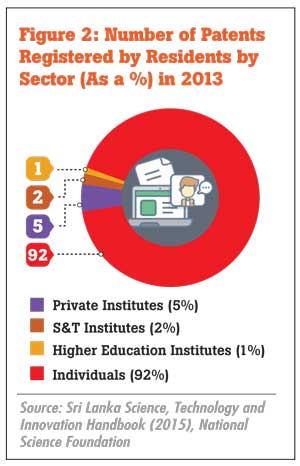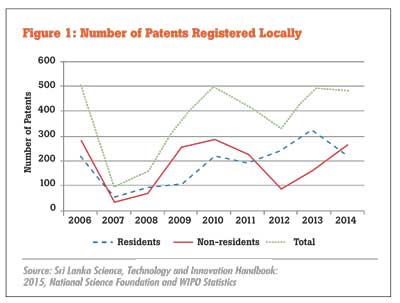27 Apr 2017 - {{hitsCtrl.values.hits}}
 April 26 marks the World Intellectual Property (IP) Day. This year, the 16th IP Day focused on the theme of ‘Innovation – improving lives’, which aims to explore how innovation makes lives healthier, safer and more comfortable.
April 26 marks the World Intellectual Property (IP) Day. This year, the 16th IP Day focused on the theme of ‘Innovation – improving lives’, which aims to explore how innovation makes lives healthier, safer and more comfortable.
A well-built IP system stimulates innovation by attracting investments, rewarding inventors, encouraging inventors to develop their ideas and ensuring that their new knowledge is protected. Almost all innovations can be protected with intellectual property rights (IPRs). Therefore, every country has recognized the importance of protecting the intellects of its people.
Sri Lanka too encourages its people in this regard, through several policies and programmes designed to enhance innovations. Some of these policies and programmes are directly linked with IPRs.
Sri Lanka was ranked 91st out of 128 countries in the Global Innovation Index (GII) in 2016. It was a drop of six places when compared with the GII in 2015. According to GII 2016, Sri Lanka is second only to India (66th place) in the South Asian region but, when compared with the other Asian countries (Singapore - sixth, China - 25th, Malaysia - 35th places) Sri Lanka falls far behind. This highlights the fact that Sri Lanka is not only lagging behind in the number of innovations but also in its protection and promotion of innovations.
Protecting innovations through IPRs
An effective and well-built IPR system consisting of one or more different IPR tools such as patents, copyrights, trademarks and trade secrets will protect the ownership of innovation and thereby, encourage innovations. Patents play a pivotal role in protecting new innovation, as it provides property rights for inventions usually for a specific period of time and provide the right to exclude others from exploiting the invention during that period.
Furthermore, to obtain a patent the inventor has to disclose the patented invention to the public, where it will provide an opportunity for others to use and develop the technology further. Therefore, the patent system is created to balance the interests of both inventors and the public.
According to Sri Lanka’s Intellectual Property Rights Act 2003, patents are available for inventions, products and processes in all fields of technology. Patents allow an inventor to control the commercial use of his/her invention.
Given the importance of patents, this blog article discusses the role of IPRs, especially patents, in stimulating innovations.
Sri Lanka: Where do we stand?
There are several criteria to evaluate Sri Lanka’s generation of innovations. One such important criterion is the number of patents registered at the National Intellectual Property Office (NIPO). Figure 1 describes how patents have been registered by residents and non-residents. It shows that from 2011 to 2013, there has been an increasing trend in residents’ patents registration, but since then, it has been decreasing.
 However, the total number of patents registered locally (residents and non-residents) indicates an increase. This suggests that the number of innovations is gradually increasing. This slow growth could be explained by cost of patenting, high cost of annual renewals, lack of awareness amongst scientists, etc.
However, the total number of patents registered locally (residents and non-residents) indicates an increase. This suggests that the number of innovations is gradually increasing. This slow growth could be explained by cost of patenting, high cost of annual renewals, lack of awareness amongst scientists, etc.

08 Jan 2025 53 minute ago
08 Jan 2025 2 hours ago
08 Jan 2025 3 hours ago
08 Jan 2025 4 hours ago